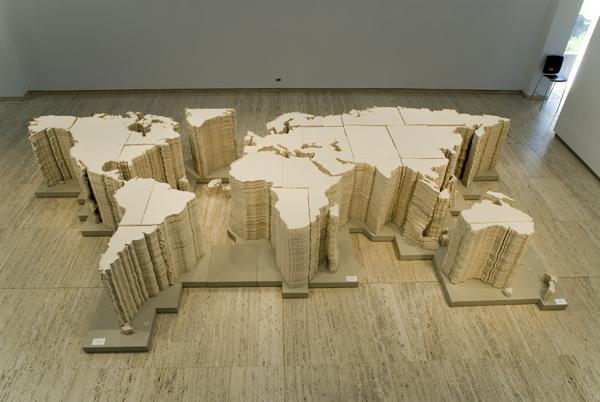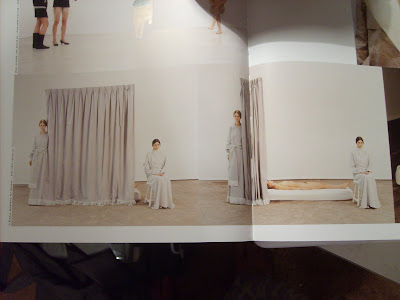In initial development of my studio work I have been looking for a 3D object to use, which encapsulates the themes of my research thus far. Primarily the texts which have spoken to me the most have included The Poetics of Space by Gaston Bachelard, The Fold by Giles Deleuse and parts from both The Visible and the Invisible and Phenomenology of Perception by Maurice Merleau-Ponty. I think what im looking at is the way a fashion space is determined through an idea of consciousness around the body, in some ways fererring to it's dualities. The fashion space Im looking at is one based in experience, the space of the wearer and the place in which the wearer experiences. This brings up many dualities including the conciouss body/the physical body, subjective/objective, inside/outside, visible/invisible, materiality/metaphore. I want to explore how a fashion garment and the wearing or experience of that garment links, overcomes, intergrates these opposites.

The object which I first found useful in displaying these ideas was a curtain. A Curtin is something which in function reveals what we can see and hides what we cannot see, blocks and facilitates, it allows physical conclusions and an infinity of wonderings. It is physical, yet also in some ways elastic. It extends and compresses. It is a boundry line between two sides which has the ability to both seperate and join. It is a flat 2D form which becomes three dimensional in through folds and drapery. It is an expanse of fabric which acts as border and sets a perimiter. Its experience is very much based on point of view, from which side of the curtain you stand. It is made up of and interley based on the function of a fold. The curtain has, "transformations [which] convey the projection, on external space, of internal spaces defined by 'hidden parameters' and variables or singularities of potention" (Deleuses 1993:16). The boundries of body concious shift, and change through the amiguous space of wearing, much like that of a curtain.
As Delueze states, "According to Lebeniz, two parts of really destinct matter [perhaps one side of the curtain and the other side of the curtain, or on the side of body experience and the side of otherness] can be inseperable, as shown not only by the action of surrounding forces that determine the curvilinear movement of the body but also the pressure of surrounding forces that determine its hardness (coherence, cohesion) or the inseparability of its parts. Thus it must be stated that the body has a degree of hardness as well as a degreee of fluidity, or that it is essentially elastic, the elstic force of bodies being the expression of the active compressive force exerted on matter." The body much like the fold holds a fluidity, a kind of will to trancend much like "the folds in the soul", but also has a hardness, an amassed matter much like "the pleates of the matter." The 'fold' of bodily experience is reiterated in the 'fold' of wearing. Again this 'fold' of experience if found in the 'fold' of the curtain.

In looking at curtains, a number of practitioners, have used this in the past as form, metaphore and something in between. Cosmic Wonders 2002 garment/installation collection ‘A Shadow Necessary for Window” shows a dress take a surreal type of emergence from a curtain with a figure placed in its form. The expanse of curtain is then pulled across to show a naked figure lying on a mattress. The peice expresses a type of intimacy of domestic habitat and clothed habitat. The connection of dressed body and naked body through the curtain creates an aesthetic of protection, and cover.
The Curtain is used by MATERIALBYPRODUCT in a number of deviceful and allegorical ways. MBP descibe thier series of curtains as an “ambiguous moment” in thier initial creative generation. Often first rendered as a type of printed screen, they give rise to the fabrication and sense of surface of the immenent collection. The curtain also refers to a sense of antiquity, as they describe, “a period when the same piece of cloth could be worn as a draped garment, used as a blanket to sleep under at night, or hung as a curtain or partition.” This giving a sense of how garment and interior overlap in shared function and form. A garment is an interior and an interoir is worn. Furthermore the curtain as used by MBP takes on a modtuar outcome, highlighting a construction between dape and cut - this most prominent in thier SS09 collection in which the ‘block out finish’ of the curtain material used, doubled in funtion allowing internal and raw cuts.

Shigeru Ban Architects in 1993 created the Curtain Wall House. This building uses conventional domestic drapery and transforms it into the exterior of a building. The curtain wall functions in changing the experience of interior/exterior conditions by its opening the closing. It sheds the curtain in a light of protection, covering and shelter in an infrastructure-type way.

To me the curtain is the possibility and threshold to connection, and within this having the ability to change the degree of which that connection is shown. It stops and allows a line of sight and a line of experience. It is also a surface. It delineates the space of view/experience. It is a piece of fabric. It's what a mum's skirt looks like from the inside when a child hides between under he legs and looks outward. Its what conceals a change-room, the change-room curtain, where I experience wear. Within its folds are pockets of intimacy, covering and space for reflection. Below are some pics of experiments I have been doing with curtains;





Hi Hannah, this is a thorough post, and you have explained many areas of your references and related them with language that is convincing. I think though some of this cleans up a few areas before it is necessary, creating definitive explanations before the work has really begun. This is one of the hardest parts of starting a research project, defining it without closing it down. Perhaps use questions more.Perhaps also consider why the curtain is a desirable device to begin your explorations, it is not that 3D until it is enacted and it is also the opposite of commercial pattern making systems involving no regular cutting process. What makes this an approach that interests you?
ReplyDelete